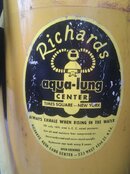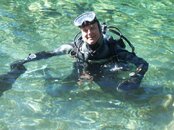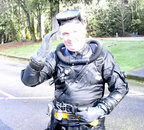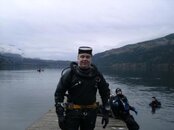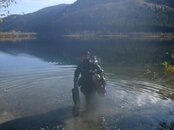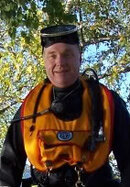- Messages
- 22,171
- Reaction score
- 2,803
- # of dives
- 5000 - ∞
As I said: "As for the diver who is over weighted and under trained, we can come up with examples of stupid human tricks 'till the cows come home, that's really not what we are here to do, we are here to examine what should be best practices." so I will not be discussing the "I don't know how to dive diver, rather I will look at what a "text book" diver would do, and what I would, in reality do.Sorry for your loss, I hate it when that happens.
As for the diver who is over weighted and under trained, we can come up with examples of stupid human tricks 'till the cows come home, that's really not what we are here to do, we are here to examine what should be best practices.
If the diver is diving wet then he might have six pints, or so, of air in his BC, (his gas weighs 4 lbs and he's likely to have about 10 lbs of suit compression). If he is diving dry he has no more than 4 pints of air in his BC (compensating for his gas). So let's go worst case: 6 pints, that's 24 lbs when it gets to the the surface, but that's not 24 lbs. instantly. It's 6 pints on the bottom, 8 pints at 66 ft., 12 pints at 33 ft, etc. There's plenty of time to dump before that air has much of an effect. So realistically his buoyancy gain is from the loss of lead (20 lbs), plus the expansion of his wet suit (add about 10 more). If he's diving dry, he gains no buoyancy from suit expansion because his shoulder valve vents the excess air off. So your calculations are way off, worst possible case is on the order of 34 lbs. regardless of the size of the BC. To put that in perspective, I've done a surface dive and made it down to the bottom of a 13 ft. pool against a little over 90 lbs of positive buoyancy (no weights, full suit and full FENZY).
So he dumps his belt, flares and vents his BC. What is the big deal? Is he wearing hand cuffs?
Second, when it comes to buoyancy, "a pint's a pound, the world arround." more or less, so there is no need to introduce cubic feet or any other measure. One pint of air displaces one pound of water, One pint of air taken down to 100 feet is 1/4 pint of air and now displaces 1/4 pound of water ... OK?
So the diver is going to lose eight lbs of buoyancy on the way down. The diver starts with four pints in his BC to compensate for the 4 lbs of gas in his full tank. So he adds 8 pints of air on his descent to compenste for his suit's 80% of 10 lbs compression, and thus arrives on the bottom with 12 pints of air in his BC that provides 12 lbs of buoyancy. The diver is now neutally buoyant.I "wagged" the gas-in-wing quantity in that example for the sake of easy math and because I didn't feel like figuring it all out. So I'll do the exact math... It looks different than what you have.
Assuming that the skilled diver is correctly weighted, and that they're both diving wet with single AL80's at the beginning of the dive, and that they both have 10 pounds of bouyancy in their suits and lose 80% of their bouyancy at 100'...
Now that's geat, but that's theory ... what's reality? I start down with no air in my BC, I don't need it. I'm a hair negative and I start to sink. As I descend I move my breathing cycle up about 5 pints (I can comfortably shift a little more than 7 lbs either way) and as I approach the bottom at 100 feet I feed about 7 pints of air into my BC to level off. Im am not neutrally buoyant.
I have no idea of where you can up with 14 lbs, I get 12 lbs, 8 for the suit and 4 for the gas, 8+4=12.The skilled diver should need about 14 pounds of bouyancy in his wing to be neutral at 100'. That's a displacement of 0.22 cuft of seawater, Thus, the bubble in the wing would be about a quarter of a cubic foot... Admittedly, much less than my example showed.
The unskilled diver needs to displace 29 pounds of seawater, so his bubble would be 0.45 cuft... About half a cubic foot.
If we start of neutral and drop a 20 lbs belt, the text book diver is suddenly 32 lbs buoyant and I am 27 lbs buoyant.If they start neutral and then drop 20 and 35 pounds respectively, they are, by definition, immediately 20 and 35 pounds bouyant. At 100'.
Here is where your logic goes south. FIrst of all, fat tissues do not become more buoyant on ascent, no part of the body does, except for trapped air spaces, and you should not have any of those. The wetsuit will never be more than 20 lbs buoyant, it is not a ballon, so if the text book diver does not vent his BC at all, he will be 12 pints of air taken to the surface plus 20 lbs of suit buoyancy, which comes out to 68 lbs. I, on the other hand, again assuming that I do not vent my BC at all, take 7 pints to the surface, for a total of 28 pounds, plus twenty lbs less ten pints that I've exhaled, moving my cycle lower, for a total of about 38 lbs positive.At 66', that bubble has gone from being 14 and 29 pounds bouyant to 19 and 39 pounds bouyant respectively. Including the expansion of fat tissues and wetsuit, and the 20 pounds and 35 pounds are now 27 and 47 pounds bouyant. (20 and 35 pounds bouyant at 3 out of 4 ATAs... So 20 and 35 pounds * 4/3rds).
At 33', our divers are now 40 and 70 pounds bouyant (20 and 35 pounds bouyant at 2 out of 4 ATAs... So 20 and 35 pounds * 4/2nds).
At 0 feet, our divers are 80 and 140 pounds bouyant (20 and 35 pounds bouyant at 1 out of 4 ATAs... So 20 and 35 pounds * 4/1sts).
No, the six lbs goes the other way, as you breathe a tank down it gets lighter (more positive) and you vent from your BC to compensate for that. Since the tank is rigid, it does not expand on the way to the surface, thus if we are looking at and end of dive incident you should subtract 16 lbs (for 4 lbs of air) or 24 lbs (for 6 lbs of air) from your totals, leaving the textbook diver at at little as 44 lbs and me at as little as 14 lbs positive upon arrival at the surface.Again, a BC will only hold so much gas... So, for example, if the BC will only hold 60 pounds of bouyancy, it will have vented the rest... But there's still inherent body and lung bouyancy and wetsuit bouyancy. Altogether, this should mean that the diver would max out at, say, 70 pounds bouyant... Somewhere between 33' and the surface for both of them.
Now's a good time to point out that we assumed above that both divers had full tanks. If, during this OOA emergency, these tanks became empty, you're gonna have to add 6 pounds to this bouyancy figure, for the loss of the gas... And that's over and above what their BCs will hold... So each would be around 76 pounds bouyant, according to your example of any catastrophic loss of all breathing gas.
I miss you point entirely. I fear that you are relying too much upon creating fear with your term, "completely uncontolled ascent." My ascent rate is quite controlled, it is on the order of what, for me, is a normal ascent ... I'm just not having to work at it at all. I am not stopping on the way up, that is true, but I made 60 FPM acents without any sort of stop for many decades and never had any problem.Alternatively, in a CESA, bouyancy would be offset by the weight belt and... All things being equal... Would equate to a maximum bouyancy of 40 and 25 pounds (with the less skilled diver's BC venting). 46 and 31 pounds bouyant if the tanks are catastrophically empty. So as I've said, a CESA IS bouyant... Just not nearly as badly. This, of course, assumes that the diver did not vent his BC on the ascent, which he probably wouldn't if he did a CESA. But it would be controllable... And faster, since swimming.
Again, it can be plainly seen why there is no point in inflating the BC to ascend, as another poster recommended. There's not enough room anyway unless the diver vents.
Dumping weight isn't much better... It only makes the problems that the diver is experiencing worse - and his ascent completely uncontrollable, which is the difference between dropping weight (EBA) and not (CESA) during the ascent.
Best of luck.'Night. Huge job tomorrow... Got a lot riding on this one.



